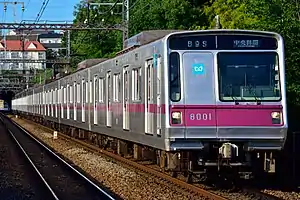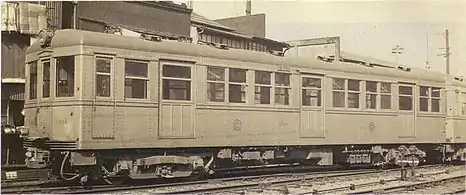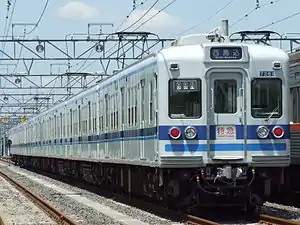Tokyo subway rolling stock
Tokyo Metro and Toei Subway own or use the following types of rolling stock.
Tokyo Metro
Hibiya Line
Hibiya Line uses PMSM trains that are 7 cars long and standard 20M length, and meter gauge (1067mm)
Tokyu Corporation formerly operated trains from the Tokyu Toyoko Line into the Hibiya Line from 1964 until 2013, when through-services between the Toyoko Line and the Tokyo Metro Fukutoshin Line commenced operations.
Present
- Tokyo Metro
- Tokyo Metro 13000 series (since 25 March 2017)
- Tobu Railway
- Tobu 70000 series (since 7 July 2017)
 Tokyo Metro 13000 series
Tokyo Metro 13000 series Tobu 70000 series
Tobu 70000 series
Former
- Teito Rapid Transit Authority (TRTA)/Tokyo Metro
- TRTA 3000 series (from 1961 until July 1994)
- Tokyo Metro 03 series (from 1988 until 28 February 2020)
- Tobu Railway
- Tobu 2000 series (from 1962 until 1993)
- Tobu 20000 series (from 1988 until 27 March 2020)
- Tokyu Corporation
- Tokyu 7000 series (original) (from 1964 until 1991)
- Tokyu 1000 series (from 1991 until 2013)
 TRTA 3000 series
TRTA 3000 series Tokyo Metro 03 series
Tokyo Metro 03 series Tobu 2000 series
Tobu 2000 series Tobu 20000 series
Tobu 20000 series Tokyu 7000 series
Tokyu 7000 series Tokyu 1000 series
Tokyu 1000 series
Tōzai Line
Tōzai Line trains are 20 m long 10-car formations, with four doors per side and longitudinal seating. The maximum operating speed is 100 km/h.
Present
- Tokyo Metro
- Tokyo Metro 05/05N series (since 1988)
- Tokyo Metro 07 series (since 2006) (transferred from Yūrakuchō Line)
- Tokyo Metro 15000 series (since 2010)
- Tōyō Rapid Railway
- Tōyō Rapid 2000 series (since 2004)
- East Japan Railway Company (JR East)
- JR East E231-800 series (since 2003)
 Tokyo Metro 05 series
Tokyo Metro 05 series Tokyo Metro 05N series
Tokyo Metro 05N series Tokyo Metro 07 series
Tokyo Metro 07 series Toyo Rapid 2000 series
Toyo Rapid 2000 series JR East E231-800 series
JR East E231-800 series
Past
- TRTA/Tokyo Metro
- Tokyo Metro 5000 series (from 1964 until 2007)
- Tokyo Metro 8000 series (from 1987 until 1988, temporary, built for Hanzōmon Line)
- JNR/JR East
- JR East 301 series (from 1966 until 2003)
- JR East 103-1000 series (from 1989 until 2003)
- JR East 103-1200 series (from 1971 until 2003)
- Tōyō Rapid
- Tōyō Rapid 1000 series (from 1996 until 2006)
 Tokyo Metro 5000 series
Tokyo Metro 5000 series JR 301 series
JR 301 series JR 103-1200 series
JR 103-1200 series Tōyō Rapid 1000 series
Tōyō Rapid 1000 series
Chiyoda Line
Chiyoda Line trains are 20 m long 10-car formations, with four doors per side and longitudinal seating. Kita-Ayase Branch service trains run in three-car formations.
Present
- Tokyo Metro
- Tokyo Metro 16000 series (since November 2010)[1]
- Tokyo Metro 05 series (since April 2014, used on Kita-Ayase Branch in 3-car formations)
- Odakyu Electric Railway
- Odakyu 4000 series (since September 2007)[2]
- Odakyu 60000 series MSE (since spring 2008, used for Metro Hakone, Metro Enoshima, Metro Morning Way and Metro Home Way)[3]
- JR East
- JR East E233-2000 series (since summer 2009)
 Tokyo Metro 16000 series
Tokyo Metro 16000 series Tokyo Metro 05 series
Tokyo Metro 05 series JR East E233-2000 series
JR East E233-2000 series Odakyu 4000 series
Odakyu 4000 series Odakyu 60000 series
Odakyu 60000 series
Former
- TRTA/Tokyo Metro
- Tokyo Metro 5000 series (from 1969 until 2014, used on Kita-Ayase Branch in 3-car formations)
- Tokyo Metro 6000 series (prototype built in 1968, used on Kita-Ayase Branch in 3-car formation)
- Tokyo Metro 06 series (from 1993 until January 2015)
- Tokyo Metro 07 series (from September until December 2008, transferred to Tōzai Line)
- Tokyo Metro 6000 series (from 1971 until November 2018)
- Odakyu
- Odakyu 9000 series (from 1978 until 1990)
- Odakyu 1000 series (from 1989 until 2010)
- JNR/JR East
- JR 103 series (from 1970 until 1986; transferred to Joban Line rapid services afterwards)
- JR 203 series (from 1982 until September 2011; 90 were transferred to overseas operations)[4]
- JR 207-900 series (from 1986 until December 2009)
- JR 209-1000 series (x2) (from December 1999 until October 2018; transferred to Chuo Line Rapid Service by December 2018.)
 Tokyo Metro 6000 series
Tokyo Metro 6000 series Tokyo Metro 5000 series
Tokyo Metro 5000 series Tokyo Metro 07 series
Tokyo Metro 07 series Odakyu 9000 series
Odakyu 9000 series Odakyu 1000 series
Odakyu 1000 series JR 103-1000 series
JR 103-1000 series JR 203 series
JR 203 series JR 207-900 series
JR 207-900 series JR East 209-1000 series
JR East 209-1000 series
Hanzōmon Line
Hanzōmon Line trains are 20 m long 10-car formations, with four doors per side and longitudinal seating.
Present
- Tokyo Metro
- Tokyo Metro 8000 series (since 1981)
- Tokyo Metro 08 series (since 2003)
- Tokyu Corporation
- Tokyu 5000 series (since 2002)
- Tokyu 8500 series (since 1978)
- Tokyu 2020 series (since 2018)
- Tobu Railway
- Tobu 30000 series (since 2003)
- Tobu 50050 series (since 2006)
 Tokyo Metro 8000 series
Tokyo Metro 8000 series Tokyo Metro 08 series
Tokyo Metro 08 series Tokyu 8500 series
Tokyu 8500 series Tokyu 5000 series
Tokyu 5000 series Tokyu 2020 series
Tokyu 2020 series Tobu 30000 series
Tobu 30000 series Tobu 50050 series
Tobu 50050 series
Future
- Tokyo Metro
- Tokyo Metro 18000 series[5]
Former
- Tokyu Corporation
- Tokyu 2000 series (from 1992 until 2018)
- Tokyu 8590 series (from 1988 until 2019)
 Tokyu 2000 series
Tokyu 2000 series Tokyu 8590 series
Tokyu 8590 series
Namboku Line
Namboku Line trains are 20 m long 6-car formations, with four doors per side.
Current
- Tokyo Metro
- Tokyo Metro 9000 series (since 1991)
- Saitama Rapid Railway
- Saitama Rapid Railway 2000 series (since 2001)
- Tokyu Corporation
- Tokyu 3000 series (since 2000)
- Tokyu 5080 series (since 2003)
- Tokyu 3020 series (since 5 January 2020)
 Tokyo Metro 9000 series
Tokyo Metro 9000 series Tokyo Metro 9000 series (5th batch)
Tokyo Metro 9000 series (5th batch) Saitama Rapid Railway 2000 series
Saitama Rapid Railway 2000 series
Yūrakuchō/Fukutoshin Lines
Yūrakuchō/Fukutoshin Line trains are 20 m long 10-car (8-car for some Fukutoshin Line trains) formations, with four doors per side and longitudinal seating.
Present
- Tokyo Metro
- Tokyo Metro 7000 series (since 1974)
- Tokyo Metro 10000 series (since September 2006)
- Tobu Railway
- Tobu 9000/9050 series (since 1987)
- Tobu 50070 series (since July 2007)
- Seibu Railway
- Seibu 6000/6050 series (since 1998)
- Seibu 40000 series (since 25 March 2017, used for S-Train)
- Tokyu Corporation and Yokohama Minatomirai Railway (Fukutoshin Line only)
- Tokyu 5050 series (since 16 March 2013)
- Tokyu 4000 series (since 10 September 2012)
- Yokohama Minatomirai Railway Y500 series (since 16 March 2013)
 Tokyo Metro 7000 series
Tokyo Metro 7000 series Tokyo Metro 10000 series
Tokyo Metro 10000 series Tobu 9000 series
Tobu 9000 series Tobu 50070 series
Tobu 50070 series Seibu 6000 series
Seibu 6000 series Seibu 40000 series
Seibu 40000 series Tokyu 5050 series
Tokyu 5050 series Tokyu 4000 series
Tokyu 4000 series Tokyu 4000 series (Shibuya Hikarie)
Tokyu 4000 series (Shibuya Hikarie) Yokohama Minatomirai Railway Y500 series
Yokohama Minatomirai Railway Y500 series
Future
- Tokyo Metro
- Tokyo Metro 17000 series[5]
Former
- TRTA/Tokyo Metro
- Tokyo Metro 07 series (from 1993 until 2007, transferred to Tōzai Line)
- Odakyu Electric Railway (Yūrakuchō Line only)
- Odakyu 60000 series MSE (used for Bay Resort occasionally)
 Tokyo Metro 07 series
Tokyo Metro 07 series Odakyu 60000 series
Odakyu 60000 series
Ginza/Marunouchi Lines
Trains on the Ginza and Marunouchi Lines run in three-door six-car formations.
Neither the Ginza nor the Marunouchi Lines have through trains into other suburban rail lines in Greater Tokyo hence the full list of rolling stock is as shown:
Ginza Line
- Present
- Tokyo Metro 1000 series (since 11 April 2012)
.jpg.webp) Tokyo Metro 1000 series
Tokyo Metro 1000 series Tokyo Metro 1000 series (retro design)
Tokyo Metro 1000 series (retro design)
- Former
- Tokyo Rapid Railway 100 series (from 1938 until 1968)
- Tokyo Underground Railway 1000 series (from 1927 until 1968)
- Tokyo Underground Railway 1100 series (from 1930 until 1968)
- Tokyo Underground Railway 1200 series (from 1934 until 1986)
- TRTA 1300 series (from 1949 until 1986)
- TRTA 1400 series (from 1953 until 1985)
- TRTA 1500 series (from 1954 until 1986)
- TRTA 1500N series (from 1968 until 1993)
- TRTA 1600 series (from 1955 until 1986)
- TRTA 1700 series (from 1956 until 1986)
- TRTA 1800 series (from 1958 until 1986)
- TRTA 1900 series (from 1958 until 1987)
- TRTA 2000 series (from 1958 until 1993)
- Tokyo Metro 01 series (from 1983 until 2017)[6]
 Tokyo Rapid Railway 1000 series
Tokyo Rapid Railway 1000 series Tokyo Underground Railway 1000 series
Tokyo Underground Railway 1000 series TRTA 1200 series
TRTA 1200 series TRTA 1500 series
TRTA 1500 series TRTA 2000 series
TRTA 2000 series Tokyo Metro 01 series
Tokyo Metro 01 series
Marunouchi Line
- Present
- Tokyo Metro 02 series (since 1988, some 3-car sets used on Hōnanchō branch)
- Tokyo Metro 2000 series (since 2019)
 Tokyo Metro 02 series
Tokyo Metro 02 series Tokyo Metro 02 series (Hōnanchō branch)
Tokyo Metro 02 series (Hōnanchō branch) Tokyo Metro 2000 series
Tokyo Metro 2000 series
- Former
- TRTA 300/400/500/900 series (from 1954 until 1996, later sold and exported for use on Line B of the Buenos Aires Metro)
- Tokyo Rapid Railway 100 series (from 1962 until 1968, transferred from Ginza Line, used for Hōnanchō branch only)
- TRTA 2000 series (from 1968 until 1981, used for Hōnanchō branch only)
 TRTA 500 series
TRTA 500 series TRTA 2000 series
TRTA 2000 series
Toei Subway
Asakusa Line
Asakusa Line trains are 18 m long 8-car formations, with three doors per side. They are also of standard gauge (1435mm) as opposed to the 1067mm gauge used on most Japanese rail lines.
Present
- Toei
- Toei 5300 series (since 1991)
- Toei 5500 series (since June 2018)
- Keisei Electric Railway, Hokusō Railway, Chiba New Town Railway and Shibayama Railway
- Keisei 3000 series (II) (since 2003)
- Keisei 3050 series (II) (since 2010)
- Keisei 3100 series (II) (since 26 October 2019)
- Keisei 3400 series (since 1993)
- Keisei 3600 series (since 1982)
- Keisei 3700 series (since 1991)
- Hokuso 7300 series (since 1991)
- Hokuso 7500 series (since 2006)
- Chiba New Town Railway 9100 series "C-flyer" (since 1994)
- Chiba New Town Railway 9200 series (since 2013)
- Chiba New Town Railway 9800 series (since 21 March 2017)
- Keikyu Corporation
- Keikyu 1500 series (since 1985)
- Keikyu 600 series (since 1994)
- Keikyu N1000 series (since 2002)
 Toei 5300 series
Toei 5300 series Toei 5500 series
Toei 5500 series Keisei 3000 series (II)
Keisei 3000 series (II) Keisei 3050 series (II)
Keisei 3050 series (II) Keisei 3100 series (II)
Keisei 3100 series (II) Keisei 3400 series
Keisei 3400 series Keisei 3600 series
Keisei 3600 series Hokuso 7300 series
Hokuso 7300 series Chiba New Town Railway 9200 series
Chiba New Town Railway 9200 series Chiba New Town Railway 9800 series
Chiba New Town Railway 9800 series Keikyu 600 series
Keikyu 600 series Keikyu N1000 series (aluminium body)
Keikyu N1000 series (aluminium body) Keikyu N1000 series (stainless steel body)
Keikyu N1000 series (stainless steel body)
Former
- Toei
- Toei 5000 series (from 1960 until 1995)
- Toei 5200 series (from 1976 until 2006)
- Keisei Electric Railway, Hokusō Railway, Chiba New Town Railway and Shibayama Railway
- Keisei 1000 series (from 1988 until 1991)
- Keisei 3000 series (I) (from 1960 until 1991)
- Keisei 3050 series (I) (from 1960 until 1993)
- Keisei 3100 series (I) (until 1995)
- Keisei 3150 series (until 1998)
- Keisei 3200 series (until 2007)
- Keisei 3300 series (until 2008)
- Keisei 3500 series (since 1972 until 2015)
- Hokuso 7050 series (from 1995 until 2003)
- Hokuso 7150 series (from 1991 until 1997)
- Hokuso 7000 series (from 1991 until 2007)
- Hokuso 7250 series (from 2003 until 2006)
- Hokuso 7260 series (from 2006 until 2015)
- Chiba New Town Railway 9000 series (from 1991 until 2017)
- Shibayama Railway 3600 series (from 2002 until 2013)
- Keikyu Corporation
- Keikyu 1000 series (from 1968 until 2008)
 Toei 5000 series
Toei 5000 series Toei 5200 series
Toei 5200 series Keisei 3000 series (I)
Keisei 3000 series (I) Keisei 3050 series (I)
Keisei 3050 series (I) Keisei 3100 series (I)
Keisei 3100 series (I) Keisei 3200 series
Keisei 3200 series Keisei 3300 series
Keisei 3300 series Keisei 3500 series
Keisei 3500 series Hokuso 7150 series
Hokuso 7150 series Hokuso 7250 series
Hokuso 7250 series Hokuso 7260 series
Hokuso 7260 series Hokuso 7000 series
Hokuso 7000 series Chiba New Town Railway 9000 series
Chiba New Town Railway 9000 series Shibayama Railway 3600 series
Shibayama Railway 3600 series Keikyu 1000 series
Keikyu 1000 series
Mita Line
Mita Line trains are 20 m long 6-car formations with four doors per side.
Present
- Toei
- Toei 6300 series (since 1993)
- Tokyu Corporation
- Tokyu 3000 series (since 2000)
- Tokyu 5080 series (since 2003)
- Tokyu 3020 series (since 5 January 2020)
Shinjuku Line
Shinjuku Line trains operate in 20 m long 8/10-car formations and have four doors per side. They also use a 1372mm track gauge.
Present
- Toei
- Toei 10-300 series (since 2005)
- Keio Corporation
- Keio 9030 series (since 2006)
- Keio 5000 series (since 2017)
 Toei 10-300 series (earlier batches)
Toei 10-300 series (earlier batches) Toei 10-300 series (later batches)
Toei 10-300 series (later batches) Keio 9030 series
Keio 9030 series Keio 5000 series
Keio 5000 series
Former
- Toei 10-000 series (from 1978 until 2018)
- Toei 10-300R series (from 2005 until 2017)
- Keio 6030 series (from 1980 until 2011)
 Toei 10-000 series (prototype)
Toei 10-000 series (prototype) Toei 10-000 series
Toei 10-000 series Toei 10-000 series (8th-batch)
Toei 10-000 series (8th-batch) Toei 10-300R series
Toei 10-300R series Keio 6030 series
Keio 6030 series
Ōedo Line
- Toei 12-000 series (since 1991)
- Toei 12-600 series (since 2011)
 Toei 12-000 series (earlier batches)
Toei 12-000 series (earlier batches) Toei 12-000 series (later batches)
Toei 12-000 series (later batches) Toei 12-600 series
Toei 12-600 series
See also
References
- Tokyo Metro news release: 環境配慮型の新型車両16000系 千代田線に導入決定!! (Environmentally friendly new 16000 series trains to be introduced on Chiyoda Line), (21 December 2009). Retrieved 22 December 2009. (in Japanese)
- "Archived copy" (PDF). Archived from the original (PDF) on 2007-02-07. Retrieved 2007-05-22.CS1 maint: archived copy as title (link)
- "Archived copy" (PDF). Archived from the original (PDF) on 2007-02-18. Retrieved 2007-10-20.CS1 maint: archived copy as title (link)
- 203系が営業運転から離脱 [203 series withdrawn from revenue service]. Japan Railfan Magazine Online (in Japanese). Japan: Koyusha Co., Ltd. 28 September 2011. Retrieved 28 September 2011.
- "Tokyo Metro to invest Yen 490bn in 2019-2021". International Railway Journal. 18 March 2019.
- 東京を走り33年…地下鉄銀座線01系が営業運転終了 12日ラストラン [Tokyo Metro Ginza Line 01 series ends revenue service after running in Tokyo for 33 years - Final run on 12 March]. Iza (in Japanese). Japan: Sankei Digital Inc. 10 March 2017. Archived from the original on 11 March 2017. Retrieved 11 March 2017.

